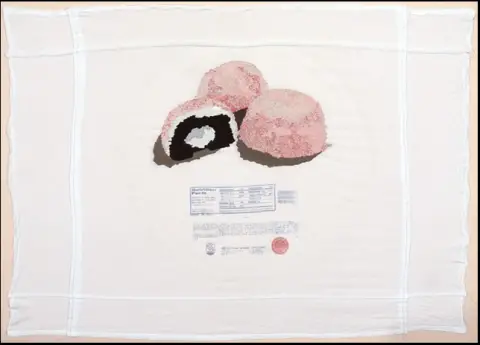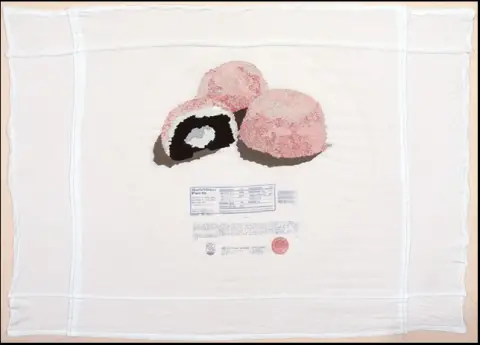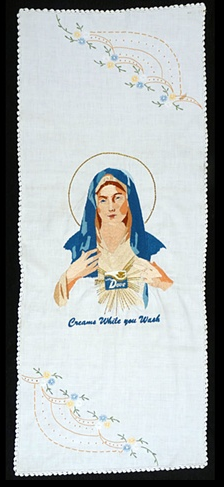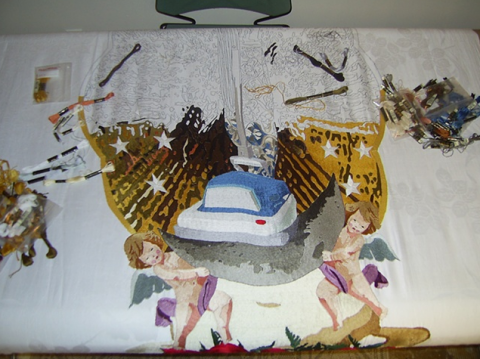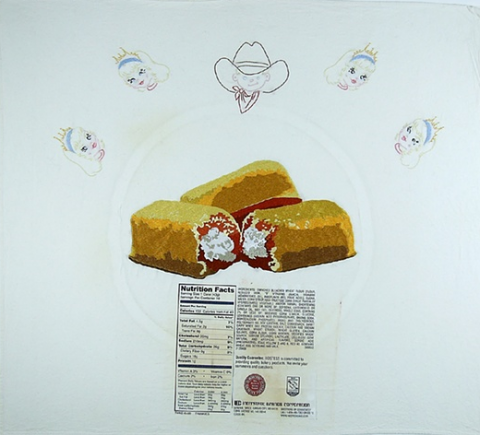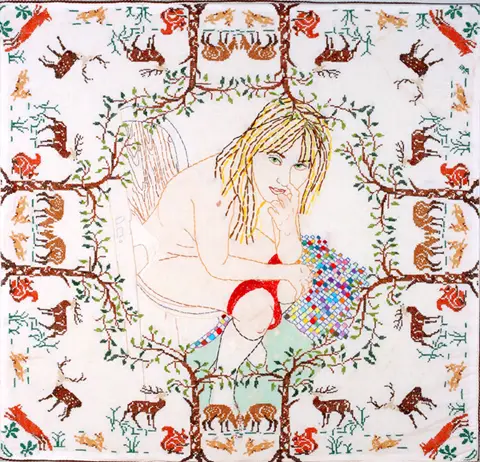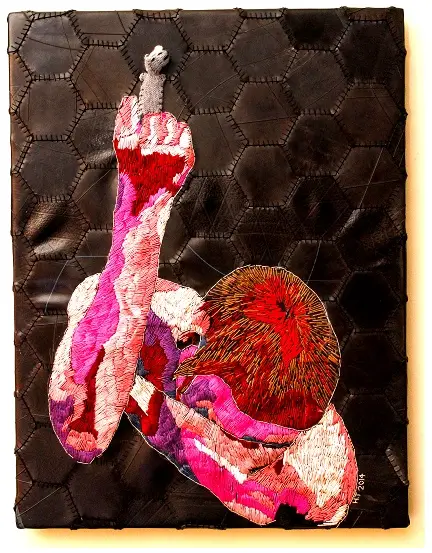
Welcome to Future Heirlooms, where we interview textile artists and explore creativity and technique.
I do not even know exactly when I saw the work of Jennifer Boe for the first time- but I do know I was immediately drawn to it with her use of vintage linens, bright colors in dense stitches, and domestic objects and references. Jennifer has worked in a number of series and though often varied in content they also seem to have a very strong conceptual thread. I was curious to understand the artist behind this work more-so here we go.
Where do you live? Does this affect your work or life as an artist?
I live in Kansas City, MO. I’m not sure how much the city itself affects my work, but it certainly affects my life as an artist. Kansas City has a really active art community; I think a lot of east and west coast people would be shocked at just how active. With so many practicing artists around, it’s a huge motivator to get stuff done so that you can have a little something to show off.
If you had to describe your work in 3 words what would they be?
What is your background as an artist?
I graduated from The Kansas City Art Institute in 2001 with a BFA in painting and creative writing. I learned how to embroider just by looking at the embroidery my grandmothers had made and then copying the stitches. I learned how to crochet the same way; by just watching my Mom. And, right now, I am teaching myself how to dye wool and needle felt. I’m kind of grateful not to have been formally trained; otherwise, I would know the “rules” and I might feel obligated to follow them. (I always feel the same way.)
Can you give us a brief description or artist statement of your current body of work?
My work has been and continues to be about the marketing and consumption of products. And, while most of the products that I embroider, or felt, or glitter are physical goods, a product can also be an idea, like religion, which is also marketed and consumed. Also, most all of the products are either food or things for the home.
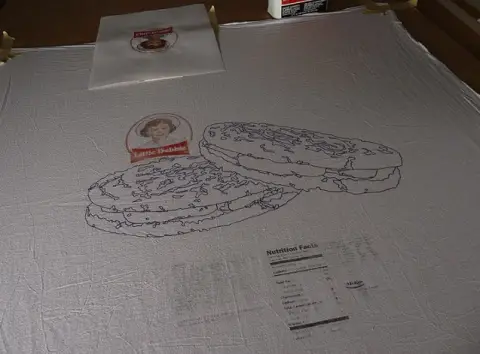
Your embroideries are very dense are they hand or machine done? What are your techniques in making such dense stitches and such accurate images?
All of my work is hand embroidered. I’ve got a few friends that think that I should try a machine and basically have them produced like prints. But, I think that would go against at least one of the reasons that I started embroidering anyway; I was making work so fast that it became mindless. I began embroidering to purposely slow down and think.
I begin my work by first setting up a still life and photographing it. Since most of my subject matter is food, I usually then eat it. Then I draw it, or sometimes I paint it with gouache and I also make a pattern to transfer to fabric. I guess that accounts for the accuracy; I am basically making myself “paint-by-numbers.” As to the density, mainly, I use a couching stitch. The threads just butt right up against each other and curve with the contours of the object.
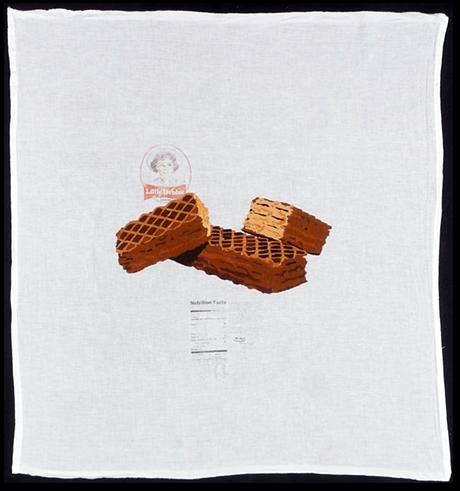
How does working with embroidery affect the conceptual aspect of your work?
One thing that it does is that it really slows me down and lets me think about what I’m doing; what I think it’s about, what others might think it is about. Something that I often think about is how long it takes to make something versus how long it takes to consume it, be that food or art. The potential tactility of the work and whether or not I will be able to convey it is also an important factor. I recently embroidered some Nutty Bars and I think the waffle pattern really made it great.
What is the role of the found linens in your work?
Well, they actually play less of a role than they did. I used to go to a lot of estate sales and buy up all of the embroidered linens. I liked the idea of working into someone else’s work that I didn’t know and who probably had no intention of making “Art”. But, then, I came upon a box of 50 flour sack towels for five bucks. So, I’ve been working through those. Although, I’ve got to say they can be a real bear. The towels are meant for cleaning and dusting and they are really good at it. They are like dust and particulate magnets.
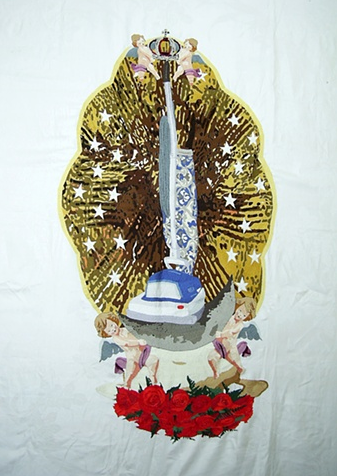
You have done a number of works that talk about the role of the woman and your fears associated with role and labor division with the household. Can you discuss how this issue is reflected and explored in your work?
Oh, here comes the questions that I really hate. It’s my work, but I still feel like I’m taking an art history test. I do think about gender roles a lot, but I’m not to sure how much of that is reflected in my work. The one work I have made that does sort of explore that is Immaculate. I started work on it just before Andy and I got married and then on through our first year of marriage. I think it is really something of a valentine to him.
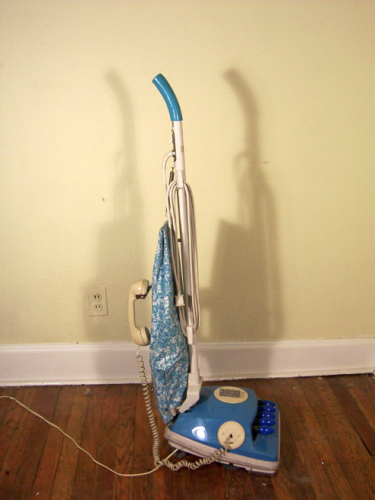
It actually references Andy’s art work and it is one of the vacuums that was lying around his studio; he later turned it into a phone. I think it’s funny how many vacuums we have in the house and how few of them work.
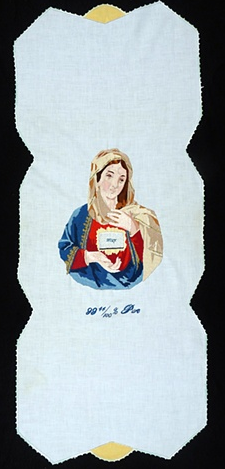
Often your work utilizes religious iconography or styles of presentation. Can you talk about how and why you use and are inspired by these references?
My typical answer is that I love the smoke and mirrors as only a non-Catholic can. And- I’ve found that most Catholics have a good sense of humor and will tolerate me playing the fool. I grew up surrounded by Christianity, but I have never been part of it and never will be. But, it is fascinating to me. And… how familiar was Mary with soap?
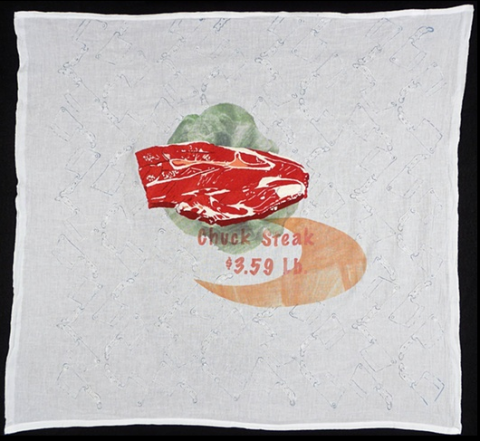
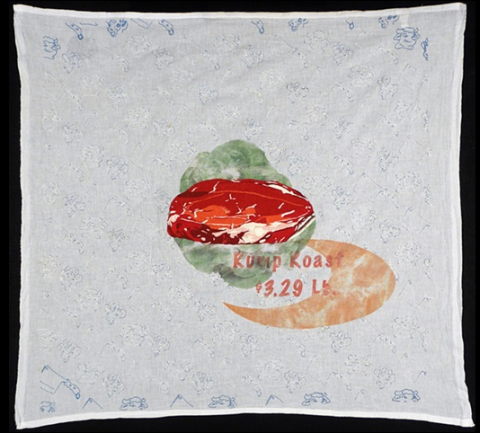
You have done a series of images based on food products and varying information from their prices, to their labels, and nutritional information. Can you talk about the social commentary that you are making and how you select the subjects of these works?
I think I could sum it up with two quotes. The first one, I’m not sure who to attribute to, “The most expensive food you buy is the food that you do not eat because it has gone bad.” The second is from S. Truett Cathy, the founder of Chick-fil-A, “Food is essential to life, therefore make it good.” I not making an endorsement for Chick-fil-A or anything, it’s just a really valid remark. As to how I select the subjects, they just sort of happen. I’ve been interested in Hostess and Little Debbie for the same reason I have been interested in religious iconography. I do not have any nostalgia for snack cakes because up until 2002 I had never had one. In this case, it is almost like an anthropological study. I like other people’s nostalgia. I latched on to the beef for two reasons, David Letterman’s “Know Your Cuts of Meat”, and my boss, who barbeques competitively and gets really pumped about meat preparation.
Your work varies in subject matter from series to series, what is the one thread that ties them all together?
What do you struggle with most as an artist?
Really, all I want to do is work in studio and make things, so just getting myself to do the business stuff that I need to do is a real chore. I think most artists struggle with that though.
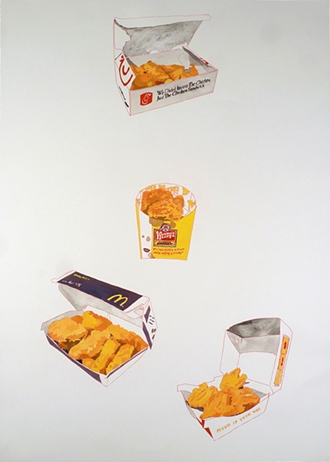
How has your work evolved since you first began working with fibers?
The subject matter of my work changed with the medium. I used to paint hunting scenes, and briefly I continued to do that once I started embroidering. In some box around here there’s a stash of underwear with hunters on the bottoms. But, food seemed a natural choice and it doubles my peril. I am walking along two cliffs’ edges; one my subject matter, the other my medium and at any moment I could fall from either one or both of them into honest to god kitsch. Since I first began, I’ve gotten more efficient. A student once asked me if there are any tricks for sewing faster. I know he was disappointed in my answer; keep your stitches neat and thread your needle with only as much thread as you can handle, otherwise you are just going to waste your sewing time untangling thread. There are no tricks.
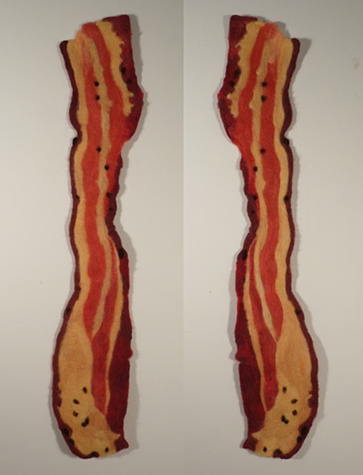
What is the next direction or step for your work?
Right now I am teaching myself how to dye, which is causing me to really miss the immediacy of paint. Waiting an hour over a simmering stock pot is kind of annoying and then waiting for it to dry… But, when I get the right color, it feels really good. The ultimate goal is needle felting my work, and making it bigger in a shorter amount of time, and three-dimensional. I’m just jumping right into it and making a four-foot slab of bacon that can be pulled apart into individual strips and worn as wraps. I’ve also been glittering images of food and cleaning products for no other reason that Martha Stewart told me to in a dream and I thought it was really funny. Andy, my husband, thinks I should send her a thank-you letter.
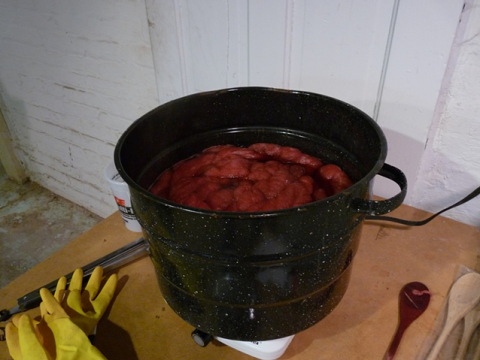
You have had a successful exhibition career as an embroiderer what is the one piece of advice that you would give to emerging artist working in the medium?
I would say be nice to others and be reliable. Don’t be fickle or forgetful and don’t be a diva. I think that pretty much goes for anybody working anywhere at anytime in their career. But for artists, I think it is especially helpful to work against the stereotypes. And, it doesn’t hurt to send thank-you notes. It’s kind of hard to pick just one piece of advice though, so I’m just going to continue on and say that it is also important not to become an “armchair artist.” I’m sure you have met some. They are those people who talk about all these wonderful ideas that they have and how they want to do this or that, but they have to work on their portfolio first and they never have any work to show besides their senior thesis. Objects in motion tend to stay in motion. While you are waiting for you “big solo show” to come, snatch up some juried ones. Just do something, anything at all.
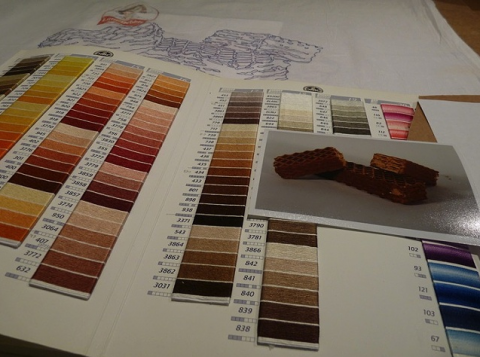
Describe your studio and studio practice.
I took the master bedroom, the largest room in our house, as my studio. It has a nice big rolling table, white walls, a huge flat file, etc. I do most of my drawing and prep work there. But, when I am working on an embroidery; doing the actual sewing, it can get pretty mindless and lonely so I move into the living room and take over the couch. Right now though, I am working on needle felting and I’ve been told pretty consistently that one should only do it in front of the television if one wants to have accidental self-inflicted stab wounds. So, I’m keeping this project in the studio and working my way through old This American Life and Radiolab episodes. (My favorite studio soundtrack too, but add in Hearing Voices.)
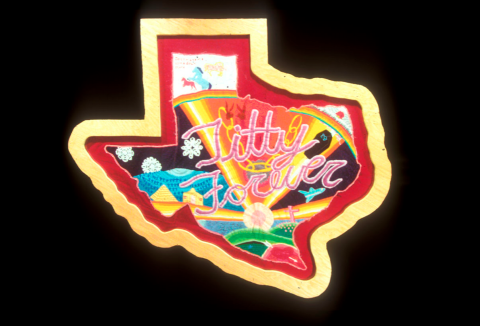
Who are the 3 most inspiring people to you as an artist and why?
Three people… I really enjoy Wayne Thiebaud’s work. It’s paintings of food of course, go figure. And then there is the texture of his paint too. I once snuck into a visiting artist lecture of his. I will always have to mention Erin Zona and her embroidery Titty Forever, that was a huge catalyst for my work. And then, my Mom, Deborah Boe; she has to be the biggest influence of all. She read a lot of Vicky Lansky’s books, specifically Feed Me! I’m Yours and Taming of the C.A.N.D.Y. Monster*: Continuously Advertised Nutritionally Deficient Yummies. If you are familiar with these books, and you take into consideration that I was raised according to these books, suddenly my work is going to make so much more sense.
What else do you spend your time doing?
When I’m not in studio or at work, I cook, workout, garden, crochet. I also curate, but I’ve had to set that aside for the time being since I’m also working on another bachelor’s degree, this one in Marketing. I also have two cats and a really awesome studiomate who is also my husband and handyman.
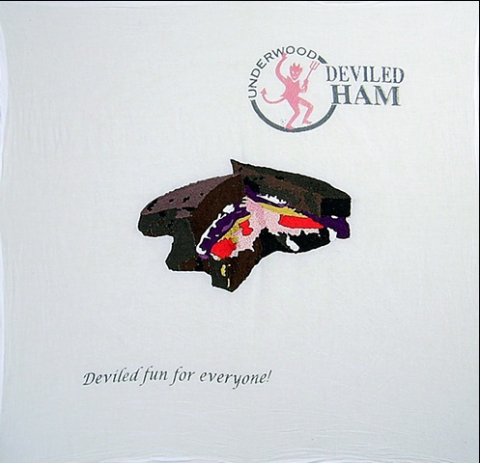
Do any of these inform your work?
I think my job and my work really inform each other. I work at The Kansas City Art Institute’s Art Store. It’s a really great job to have as a practicing artist. I only have to work when the students are there, so I have the entire summer to myself for studio work. Working at the store has influenced my choice of materials and my choices have also affected the store’s merchandise. For example, last year I decided that the store needed a full DMC embroidery floss display, more sewing notions, and some knitting and crochet needles because I didn’t want to drive 20 minutes to get my supplies. On the flip side, about that same time, last year, a student came in with a project she was working on tucked under her arm; I asked her what she was working on and I got a crash course on needle felting.
I feel like more than anything it is my art that informs my life. I started cooking and got a gym membership the same year and month that I began embroidering food. And the decision to go for a marketing degree has also definitely been influenced by my art.
Give us an idea of a day in the life of you.
Where can we see your work?
I just put together a new website: jenniferboe.com
I love the directness and succint-ness of Jennifer’s interview and really enjoyed learning more about her and her work. Cannot wait to see what happens next.
Until next time keep your needle threaded.

